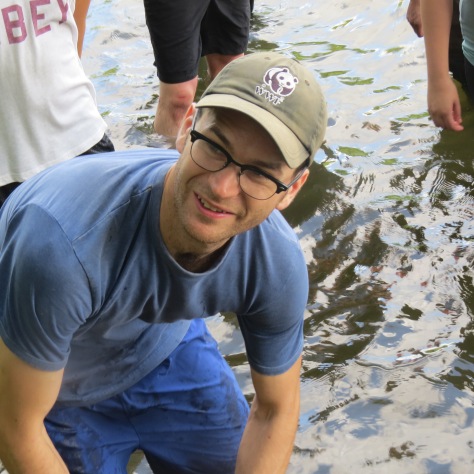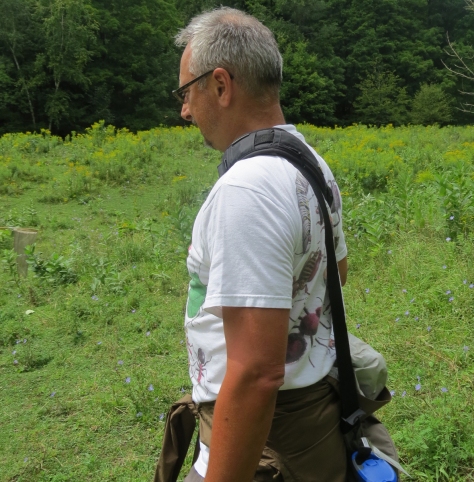By Art Goldsmith
August 19, 2015
Another fine summer day in August found me in the company of Grégory Bulté and his Ecology Field Course. Grégory is an instructor at Carleton University’s Biology Department, and according to the university’s website, he is:
“…broadly interested in the ecology, evolution and conservation of animals.”
What this does not tell you is that Grégory’s enthusiasm and knowledge about the life around Lake Opinicon and the wetlands bordering the lake, are boundless.
Officially the course is called “Field Ecology & Natural History” and this year was offered to 12 students during the last two weeks of August at QUBS.
Grégory, with his blue t-shirt in the foreground, here supervises the survey of some of the animals that live along the shores of Lake Opinicon, some rarely being seen at all. The purpose of this field study is to learn about the diversity of the lake and surrounding lands.

Turtles, fish, frogs and snakes are briefly captured, photographed, identified and then released. Lake Opinicon is home to some less common turtles, like the Northern Map Turtle (Graptemys geographica) and the Eastern Musk Turtle (Sternotherus odoratus). Note the excellent Latin species names, “geographica” and “odoratus”. They are both so descriptive of the animals. Map Turtles are named for the markings on their shells, which are reminiscent of the lines of a topographical map. Musk Turtles are also called Stinkpots, because they emit a stinky liquid from their musk glands when disturbed.

Below is a photo by your blogger of a very shy Musk Turtle taken at Lake Opinicon a few years ago. It is rare to see one out of the water. They do, on occasion, emerge onto a snag that angles out of the water, like this one, usually in an area that is well hidden. These are small turtles, usually less than 13 centimetres long. Map Turtles are among our larger turtles. Females in Lake Opinicon have measured up to 26.5 cms long and males up to half of that length. They are often seen basking on larger rocks in our rivers and lakes in Eastern Ontario.




Two of the many representatives of the Cyprinidae family (minnows and carp) in Lake Opinicon. Above is the Blackchin Shiner (Notropis heterodon) and below is the Golden Shiner (Notemigonus crysoleucas). The Blackchin Shiner is native to the Great Lakes‒St. Lawrence basin. It is a small fish, rarely exceeding 6 cms. The Golden Shiner may grow up to 30 cms., although most are in the size range pictured below. This popular bait fish is native to much of eastern and central North America and has been accidentally introduced well beyond its native range.
Frogs abound in and around the lake. The first two photos, above, feature a frog that rarely leaves the water, the American Bullfrog (Lithobates catesbeianus). Our largest frog in Ontario, the Bullfrog is very aggressive with other frogs—and anything else that moves! The third photo, above right, is a Green Frog (Lithobates clamitans). This is also a large, mostly aquatic frog, which is frequently mistaken for the Bullfrog. Note the clearly visible ridges running down the sides of this frog’s back. These ridges are distinguishing marks of the Green Frog. Below left is a photo of a Leopard Frog (Lithobates pipiens). Leopard Frogs travel far from the water during the summer months and return to overwinter in lakes and ponds. Below top centre is a Wood Frog (Lithobates sylvaticus), distinguished by facial side masks. Scrunched up on the Milkweed leaf, below right, is a Grey Tree Frog (Hyla versicolor), our loud summer frog. Its call is often mistaken for a bird. As the Latin name suggests, the Grey Tree Frog changes colour to match its surroundings for better camouflage. The Green Frog and Leopard Frog photos were taken by Art Goldsmith. The remaining four photos were taken by Grégory Bulté.
The other group of common, and usually hidden, amphibians is the salamander (above lower row). The three species above are best seen in early spring when spring melt waters and warm rains form ponds and pools where many salamanders breed in the evening hours. These salamanders spend most of their time dug into the soil or beneath rocks and fallen tree limbs in moist forests where they hunt for invertebrates. The three of Ontario’s 12 species shown here are, from left, Blue-spotted (Ambystoma laterale), Spotted (Ambystoma maculatum), and the lung-less Eastern Red-back (Plethodon cinereus). The latter is a member of the Plethodontidae family. The species in this family have no lungs, and therefore are restricted to moist, terrestrial habitats where they breed and lay their eggs. The other two Ontario members of this family are the Two-Lined and the Dusky Salamanders, neither of which have been recorded at QUBS.
For a slight change of focus, we look at a few reptiles. Above are two photos of a Northern Water Snake (Nerodia sipedon sipedon) that posed for students. This common reptile is found in and around ponds, lakes and rivers throughout the southeastern portion of Ontario. Below is a much rarer species, the Eastern or Grey Ratsnake (Pantherophis spiloides), an effective predator of rodents and other small animals. The large tracts of conservation lands protected by QUBS are vital to the Ratsnake’s survival as the population in the Rideau Lakes is threatened; whereas in southern Ontario, it is endangered.
Of course, the underpinnings of any functioning ecosystem are its wealth of native plants and fungi, both macroscopic and microscopic. Fungi make up a very large percentage of the Earth’s biomass. Then there are the invertebrates—the huge diversity of arthropods in Eastern Ontario, and the other invertebrate phyla—all forming the base of food and energy production for all of us vertebrates. The previous blog post featured the entomology field course and just a sample of the insects to be found in the area around QUBS. Here are a few more insects , other invertebrates and a small sample of the local plants.
Note that fungi will be the subject of my next post, Richard Aaron’s Fabulous Fall Fungi field course.
Widespread throughout North America and ecologically significant in our lakes, ponds and marshes, the Yellow Pond-lily (Nuphar lutea), pictured above left provides shelter, food and stabilization for many animals, including some of the aquatic invertebrates. To the right of the Pond-lily is a typical dragonfly (Order Odonata) nymph. The next photo is a freshwater crustacean (possibly the Waterlouse, a species of the genus Asellus, Order Isopoda). On the far right in this sequence of four photos, one of our Leech (Hirudinea) species is pictured. Healthy ponds and lakes are teeming with these and many other invertebrates, zooplankton and phytoplankton, which provide the basic food for all larger species.

We will explore in great detail the world of the fungi in our next post. I didn’t see this fungus (above) during the fungi course though. The Laetiporus sulphureus, which has a preference for Red Oak, has several common names, including Sulphur Shelf and Chicken-of-the-Woods.
Above, these are aquatic Leaf Beetles, Donacia sp., mating and another common aquatic invertebrate, a Damselfly nymph (Odonata).
We are not seeing as many of these on Milkweed as we have in the past. In a walk with two other naturalists recently, we thought it would be approrpiate to change the name of the Common Milkweed to Monarch Flower, to honour this plant which hosts the Monarch Butterfly caterpillar, like the one shown above.
Hay fields, as in the stunning photo above, are an excellent habitat to collect a wide diversity of insects and other Arthropods. Lastly, the Grégory Bulté Ecology Field Course class of 2015.










